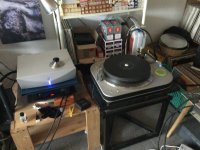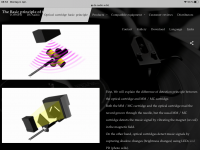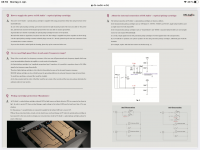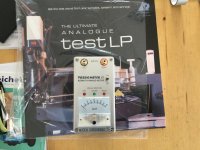On the subject of using an elliptic equalizer to remove warp I used mine which has 75/150/300 Hz high pass response in side/vertical. Because its used for mastering these frequencies are far higher than they would need to be for warp reduction. My EEQ has allpass correction in Mid so that the crosstalk curve, which is a subtractive derived response, is also 12 dB/octave.
I tried the EEQ for warp reduction anyway and subtracted the input and output of the Side HP filter to listen to the residual being removed.
On a highly-warped record (aided by placing a nickle under the disc) I could hear what sounded like granular surface noise modulated by the warp frequency. I didn't explore why, but it seemed like the lack of vertical compliance was causing some form of high-order harmonic or IM distortion as it rode the warp.
Having used 75-300 Hz frequencies experimentally in Side I was surprised at what was being removed and how little musical content leaked into Vertical.
On headphones the queasiness of out-of-polarity LF warp material is removed and the reduction of Doppler shift and woofer flap on monitors is significant.
I tried the EEQ for warp reduction anyway and subtracted the input and output of the Side HP filter to listen to the residual being removed.
On a highly-warped record (aided by placing a nickle under the disc) I could hear what sounded like granular surface noise modulated by the warp frequency. I didn't explore why, but it seemed like the lack of vertical compliance was causing some form of high-order harmonic or IM distortion as it rode the warp.
Having used 75-300 Hz frequencies experimentally in Side I was surprised at what was being removed and how little musical content leaked into Vertical.
On headphones the queasiness of out-of-polarity LF warp material is removed and the reduction of Doppler shift and woofer flap on monitors is significant.
A green adventureLooks like an adventure.
Must finish my EEQ so I can test this.Having used 75-300 Hz frequencies experimentally in Side I was surprised at what was being removed and how little musical content leaked into Vertical.
Thanks Hans!
There is a circuit description here: https://www.proaudiodesignforum.com/forum/php/viewtopic.php?f=7&t=1179
Wayne,Thanks Hans!
There is a circuit description here: https://www.proaudiodesignforum.com/forum/php/viewtopic.php?f=7&t=1179
A small typo in the above posting mentioning 25 jan 2021 as the date of announcement.
This should be of course 25 jan 2022.
Hans
You really have to give this cartridge some time in the on position. There is a capacitor bank of 330.00 uF that needs some charging. Of cause I listened right away after some sloppy adjustments and the sound I got was edgy and sterile. On the next day I tried to adjust azimuth. I used the Analogue Productions Test LP and the terrible named Fozgometer. However I adjusted azimuth, I got different readings for the left and right channel. 25 in the Right and 35 in the left. I then started to listen more seriously, but the difference of -25% in the right channel compared to the left channel bugged me. I was on the verge to talk to the importers if they have recognized something like that before. Luckily today I solved the problem. The anti skating mechanism did not work because the wire that lifts the weight was too long. I shortened it, adjusted it and then I got a reading of 32 in both channels. That tells me that an arm with an angled Headshell really needs an anti skating mechanism.
Attachments
Something else. This cartridge- equalizer combination is quiet. With my ear on the tweeter there is a faint high freq hiss. On the woofer I hear some humm but that is even much lower then the hiss. In the listening Seat I can not hear any noise and that is in a very quiet room on the country side. It is too early to judge the sound but the results now are fascinating.
Joachim, I am very much interested in the results with that optical cartridge. The way I see it (which may not be entirely correct, but I'm sure I will be corrected ;-) is that the optical part bypasses the transfer of the signal from the vibrating cantilever to the coil.
It does not do anything for the vibration of the tip in the groove, the accuracy of the tip to cantilever translation and any resonances etc in that part.
So what would interest me is what the final result is.
Jan
It does not do anything for the vibration of the tip in the groove, the accuracy of the tip to cantilever translation and any resonances etc in that part.
So what would interest me is what the final result is.
Jan
I do find that comment interesting. However, I have a feeling that many cartridges now a days are voiced to have a lift in the upper region to make the LP's sound fresh and perhaps a little "CD-like". Again, just my suspicion based on many of the measurements I have seen in HiFi-News and HiFi-World which are some of the only magazines doing cartridge measurements.It sounds very realistic. Something like SACD or HiRes streaming.
Some advantages are very low moving mass and a very high output with a nominal 70mV @ 5cm/ sec
https://www.hifinews.com/content/ds-audio-ds-003-cartridge-lab-report
Mogens
But isn't the moving mass just the same as a 'normal' cartridge? As I read it, they pick off the vibrations of the shank by optical means, but the shank still vibrates normally from following the groove.It sounds very realistic. Something like SACD or HiRes streaming.
Some advantages are very low moving mass and a very high output with a nominal 70mV @ 5cm/ sec
What they bypass is the conversion of the movements to the core output, MM or MC.
I can understand that they can set the output level almost arbitrarily high, noise allowing.
But the mass still has to be moved, because they need that to pick up optically with a reflective surface on the shank,.
Jan





